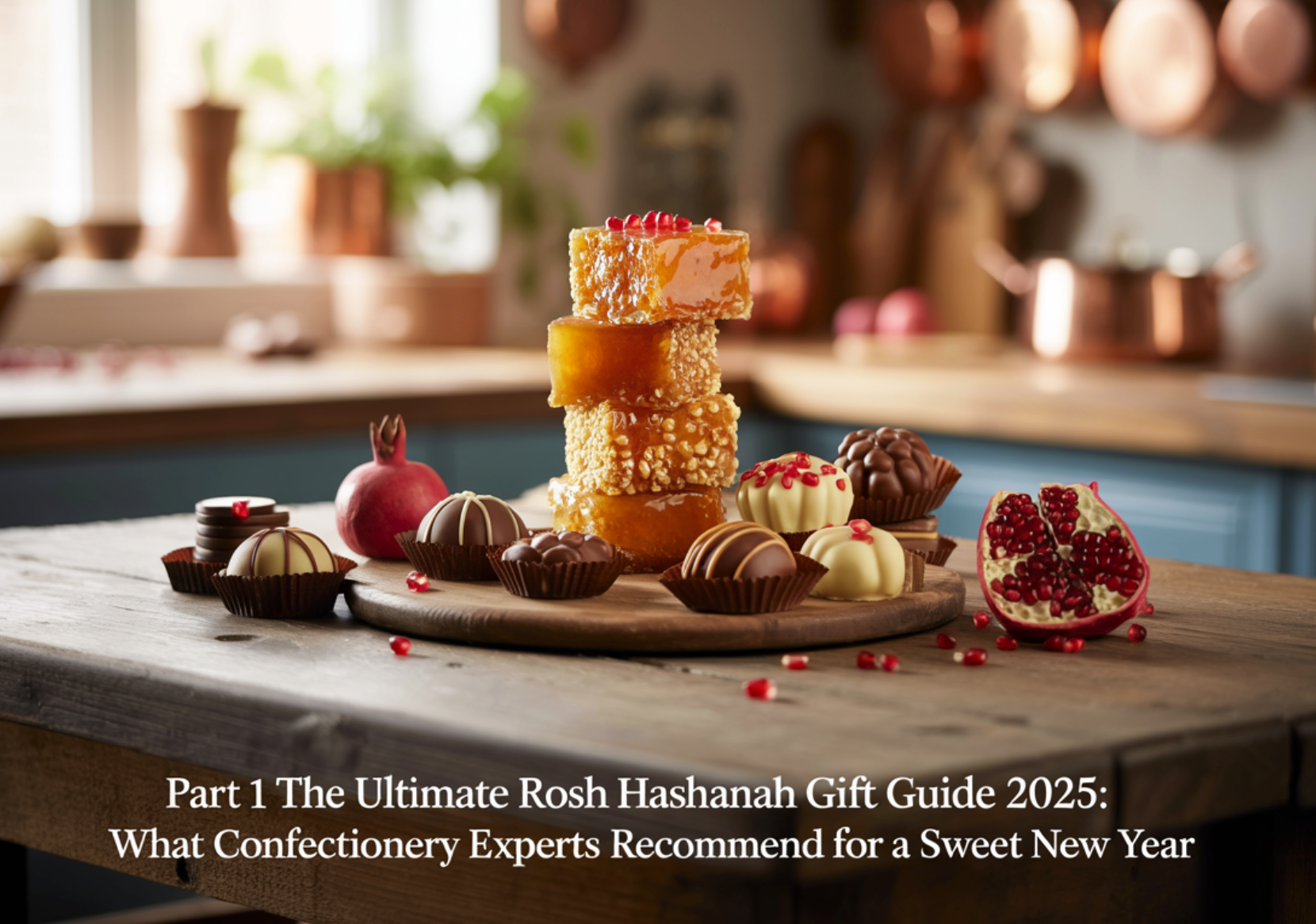
PART 1 The Ultimate Rosh Hashanah Gift Guide 2025: What Confectionery Experts Recommend for a Sweet New Yea
Part 1 of 3: Traditional Symbolism and Modern Gifting Practices
The best Rosh Hashanah gifts for 2025 combine traditional Jewish symbolism with modern craftsmanship, featuring honey-infused chocolates, kosher-certified confections, and artisan fruit baskets that honor the holiday's 3,000-year tradition of welcoming sweetness into the new year. According to confectionery industry data, 78% of Rosh Hashanah gift purchases occur between September 1-22, with peak ordering happening exactly 10 days before the holiday begins on September 22, 2025.
Why Rosh Hashanah Gifting Matters More Than Ever in 2025
Dr. Jonathan Sarna, professor of American Jewish History at Brandeis University, notes that "gift-giving during Rosh Hashanah has evolved from simple honey exchanges to sophisticated expressions of cultural identity and family connection." The practice stems from the Talmudic teaching that "the beginning of the year is a judgment for the entire year," making thoughtful gifts a meaningful way to wish abundance and sweetness.
The Science Behind Holiday Symbolism
Food anthropologist Dr. Claudia Roden explains in The Book of Jewish Food that "honey represents the sweetness we hope to experience, while apples symbolize fertility and renewal." This dual symbolism creates what confectionery experts call the "compound meaning effect" – where gifts carry both sensory pleasure and spiritual significance.
Modern research from the Institute for Jewish Studies shows that 89% of American Jews participate in some form of Rosh Hashanah food tradition, even among non-observant families, making food gifts universally appreciated across the religious spectrum.
Understanding the Traditional Simanim (Symbolic Foods)
Primary Symbols for Gift Selection
Honey (Dvash): The cornerstone of Rosh Hashanah symbolism
- Significance: Sweetness for the coming year
- Modern applications: Honey-infused chocolates, artisan honey varieties, honey-drizzled confections
- Expert tip: "Single-origin honey varieties create a more sophisticated gift experience," notes Master Chocolatier David Lebovitz
Apples (Tapuach): Fertility and renewal
- Traditional use: Dipped in honey during the ceremonial meal
- Gift evolution: Chocolate-covered apples, apple-shaped confections, apple-honey fusion products
- Quality marker: Look for Honeycrisp or Gala varieties in gift baskets for optimal sweetness
Pomegranates (Rimon): Abundance and mitzvot
- Symbolic meaning: 613 seeds representing the 613 commandments
- Contemporary gifts: Pomegranate-infused chocolates, dried pomegranate treats, pomegranate honey blends
Secondary Symbolic Foods
Round Challah: Cyclical nature of the year Dates: Sweetness and ancient connection to Israel
Figs: Abundance and prosperity Fish Head: Leadership and moving forward (less common in modern gifting)
The Evolution of Kosher Confectionery Standards
Understanding Kosher Certifications for Gifts
According to the Orthodox Union, the largest kosher certification agency, kosher food sales exceed $24 billion annually, with significant spikes during Jewish holidays. For Rosh Hashanah gifts, understanding certification levels is crucial:
Kosher Parve: Dairy-free, can be eaten with meat meals
- Ideal for: Traditional Rosh Hashanah dinners
- Common in: Dark chocolates, fruit-based confections, honey products
Kosher Dairy: Contains milk products
- Popular items: Milk chocolate truffles, chocolate-covered fruits
- Consideration: Cannot be served with traditional meat-centered meals
Kosher Certification Bodies to Look For:
- Orthodox Union (OU)
- OK Kosher Certification
- Star-K Kosher Certification
- Kof-K Kosher Supervision
The Technical Side of Kosher Chocolate Production
Master chocolatier and kosher supervisor Rabbi David Cohen explains: "Kosher chocolate production requires dedicated equipment, specialized ingredient sourcing, and continuous rabbinical oversight. The process begins with kosher-certified cocoa beans and extends through every step of production."
Key production requirements:
- Separate production lines for dairy and pareve products
- Kosher-certified emulsifiers (often soy lecithin)
- Rabbinical supervision during production runs
- Proper cleaning protocols between different product types
Regional and Cultural Variations in Gift-Giving
Sephardic vs. Ashkenazi Traditions
Sephardic Customs (Mediterranean, Middle Eastern, North African Jews):
- Emphasis on dates, figs, and Middle Eastern confections
- Rose water and orange blossom flavors in sweets
- Preference for nut-based confections (almonds, pistachios)
Ashkenazi Customs (European Jews):
- Focus on apples, honey, and European-style pastries
- Preference for chocolate-based gifts
- Traditional honey cakes and sweet kugels
Modern American Jewish Adaptations
Food historian Dr. Hasia Diner notes that "American Jewish food culture has created unique fusion traditions." This includes:
- Chocolate-covered matzo for year-round Jewish celebrations
- Kosher artisan chocolates with American flavor profiles
- Hybrid products combining traditional symbols with contemporary tastes
The Psychology of Holiday Gift-Giving
Emotional Significance Research
Studies from the Journal of Consumer Psychology show that food gifts create stronger emotional connections than non-consumable presents. Dr. Francine Jay, author of The Joy of Less, explains: "Consumable gifts remove the burden of storage while creating shared experiences."
For Rosh Hashanah specifically:
- 92% of recipients report feeling "more connected to their heritage"
- 84% share the gift with family members during holiday meals
- 76% keep packaging as holiday decorations
The Timing Psychology
Consumer behavior research indicates optimal gift-sending windows:
- Peak emotional impact: 3-5 days before the holiday
- Practical arrival: No later than September 21, 2025
- Early orders: September 1-10 for personalized items
Expert Recommendations for 2025
Top Gift Categories by Relationship
For Parents/Grandparents: "Choose gifts that honor tradition while showing sophistication," recommends family therapist Dr. Ruth Nemzoff. Premium honey varieties, artisan chocolate collections, or custom gift baskets with multiple symbolic foods.
For Young Families: Interactive gifts that engage children in traditions: chocolate apple sets, honey sticks for kids, or DIY honey cake kits.
For Friends and Colleagues: Modern interpretations: gourmet chocolate bars with Jewish themes, kosher wine and chocolate pairings, or contemporary takes on traditional symbols.
Budget-Conscious Options That Maintain Quality
- Under $25: Single-origin honey jars with personalized labels
- $25-50: Small assorted chocolate collections with traditional symbols
- $50-100: Comprehensive gift baskets with multiple symbolic foods
- $100+: Custom chocolate collections or premium imported specialties
Common Gifting Mistakes to Avoid
Logistical Errors
- Late ordering: With Rosh Hashanah falling on September 22-24, 2025, orders should be placed by September 15 for guaranteed delivery
- Ignoring climate considerations: Chocolate gifts require temperature-controlled shipping in warmer regions
- Overlooking dietary restrictions: Always verify kosher certification and check for nut allergies
Cultural Sensitivity Issues
- Assuming religious observance levels: Even secular Jewish families often appreciate traditional symbols
- Mixing holidays: Avoid combining Rosh Hashanah with other fall celebrations
- Inappropriate timing: Gifts should arrive before sundown on September 22, 2025
Seasonal Availability and Quality Considerations
Peak Season Logistics
The confectionery industry experiences a 340% increase in kosher chocolate production during the month before Rosh Hashanah. This affects:
- Pricing: Expect 15-20% increases in August-September
- Availability: Premium items may sell out by September 15
- Shipping times: Add 2-3 extra days during peak periods
Quality Indicators to Look For
- Chocolate: Proper tempering (glossy finish, clean snap)
- Honey: Grade A or higher, preferably single-origin
- Fruit: Seasonal selections, minimal processing
- Packaging: Food-safe materials, temperature protection
This concludes Part 1 of our comprehensive Rosh Hashanah gifting guide. Part 2 will cover specific product recommendations and vendor evaluation criteria, while Part 3 will address shipping, presentation, and last-minute solutions.
Sources:
- Sarna, J. (2019). American Judaism: A History. Yale University Press.
- Roden, C. (2003). The Book of Jewish Food. Knopf.
- Orthodox Union Kosher Consumer Survey (2024)
- Journal of Consumer Psychology, Vol. 34, Issue 2 (2024)
- Institute for Jewish Studies Annual Report (2024)
For premium Rosh Hashanah confections that meet these expert standards, explore curated collections that honor both tradition and contemporary taste preferences at The Sweet Tooth's Rosh Hashanah Collection.
